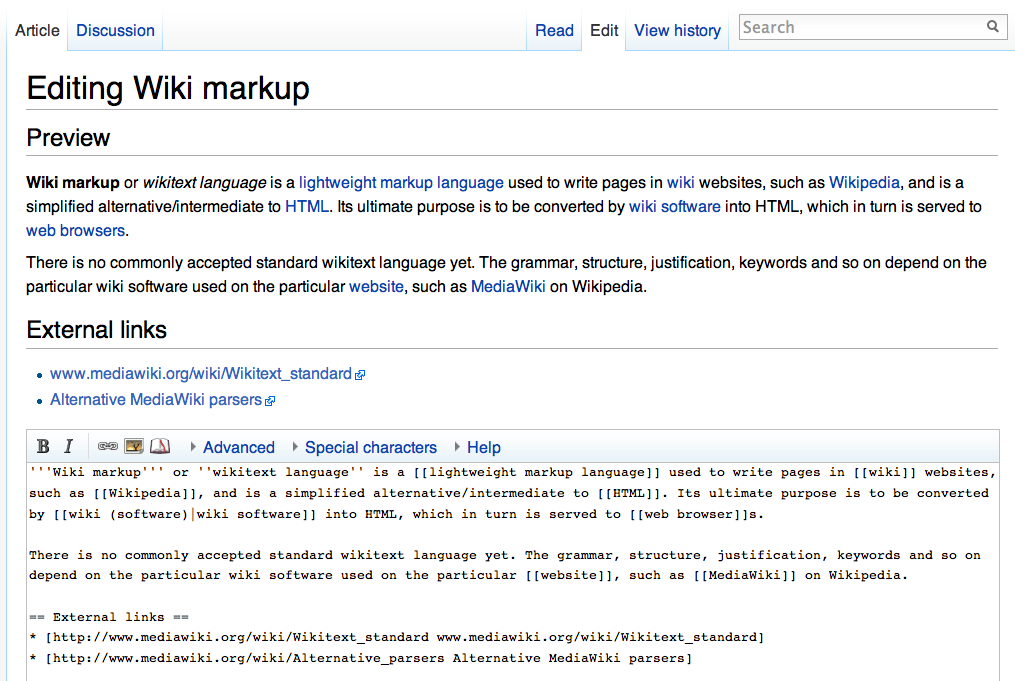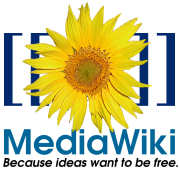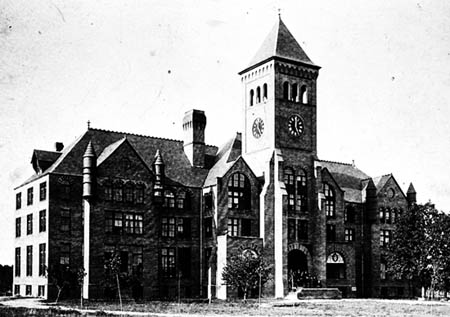|
OpenWetWare
OpenWetWare is a wiki whose mission is "to support open research, education, publication, and discussion in biological sciences and engineering." OpenWetWare was created by graduate students at MIT on April 20, 2005. Initially, it served as a private lab wiki for the labs of Drew Endy and Tom Knight at MIT. The site was opened up to allow any lab to join on June 22, 2005. As of April 6, 2007 the site hosted 100 research laboratories from over 40 institutions, including Boston University, Brown University, Caltech, Cambridge Research Institute, CNRS, Duke University, and many others. In addition to laboratories, a number of scientific communities are based on the site, including synthetic biology, Mimulus, and the BioBricks Foundation. One scientific community is the iGEM community with over 60 different teams represented on June 28, 2013, including the NRP-UEA-Norwich team and the Groningen team. OpenWetWare runs on MediaWiki software on Linux servers. All content is avail ... [...More Info...] [...Related Items...] OR: [Wikipedia] [Google] [Baidu] |
Drew Endy
Andrew (Drew) David Endy (born 1970) is a synthetic biologist and tenured associate professor of bioengineering at Stanford University, California. Education and Work History Endy received his PhD from Dartmouth College in 1997 for his work on genetic engineering using T7 phage. Endy was a junior fellow for 3 years and later an Assistant Professor of Biological Engineering at MIT, from 2002-2008. In 2008, Endy moved to Stanford University, where he currently serves as an Associate Professor of Bioengineering. Research With Thomas Knight, Gerald Jay Sussman, Randy Rettberg, and others at MIT, Endy worked on synthetic biology and the engineering of standardized biological components, devices, and parts, collectively known as BioBricks.From the cells up '' |
Wiki
A wiki ( ) is an online hypertext publication collaboratively edited and managed by its own audience, using a web browser. A typical wiki contains multiple pages for the subjects or scope of the project, and could be either open to the public or limited to use within an organization for maintaining its internal knowledge base. Wikis are enabled by wiki software, otherwise known as wiki engines. A wiki engine, being a form of a content management system, differs from other web-based systems such as blog software, in that the content is created without any defined owner or leader, and wikis have little inherent structure, allowing structure to emerge according to the needs of the users. Wiki engines usually allow content to be written using a simplified markup language and sometimes edited with the help of a rich-text editor. There are dozens of different wiki engines in use, both standalone and part of other software, such as bug tracking systems. Some wiki engines ... [...More Info...] [...Related Items...] OR: [Wikipedia] [Google] [Baidu] |
MediaWiki Websites
MediaWiki is a free and open-source wiki software. It is used on Wikipedia and almost all other Wikimedia websites, including Wiktionary, Wikimedia Commons and Wikidata; these sites define a large part of the requirement set for MediaWiki. It was developed for use on Wikipedia in 2002, and given the name "MediaWiki" in 2003. MediaWiki was originally developed by Magnus Manske and improved by Lee Daniel Crocker. Magnus Manske's announcement of "PHP Wikipedia", wikipedia-l, August 24, 2001 Its development has since then been coordinated by the Wikimedia Foundation. MediaWiki is written in the PHP programming language and stores all text content into a database. The software is optimized to efficiently handle large projects, which can have terabytes of content and hundreds of thousands of views per second. Because Wikipedia is one of the world's largest websites, achieving scalability through multiple layers of caching and database replication has been a major concern for ... [...More Info...] [...Related Items...] OR: [Wikipedia] [Google] [Baidu] |
Share-alike
Share-alike (🄎) is a copyright licensing term, originally used by the Creative Commons project, to describe works or licenses that require copies or adaptations of the work to be released under the same or similar license as the original. Copyleft licenses are free content or free software licenses with a share-alike condition. Two currently-supported Creative Commons licenses have the ShareAlike condition: Creative Commons Attribution-ShareAlike (a copyleft, free content license) and Creative Commons Attribution-NonCommercial-ShareAlike (a proprietary license). The term has also been used outside copyright law to refer to a similar plan for patent licensing. Copyleft Copyleft or libre share-alike licenses are the largest subcategory of share-alike licenses. They include both free content licenses like Creative Commons Attribution-ShareAlike and free software licenses like the GNU General Public License. These licenses have been described pejoratively as viral licenses ... [...More Info...] [...Related Items...] OR: [Wikipedia] [Google] [Baidu] |
Creative Commons License
A Creative Commons (CC) license is one of several public copyright licenses that enable the free distribution of an otherwise copyrighted "work".A "work" is any creative material made by a person. A painting, a graphic, a book, a song/lyrics to a song, or a photograph of almost anything are all examples of "works". A CC license is used when an author wants to give other people the right to share, use, and build upon a work that the author has created. CC provides an author flexibility (for example, they might choose to allow only non-commercial uses of a given work) and protects the people who use or redistribute an author's work from concerns of copyright infringement as long as they abide by the conditions that are specified in the license by which the author distributes the work. There are several types of Creative Commons licenses. Each license differs by several combinations that condition the terms of distribution. They were initially released on December 16, 2002, by ... [...More Info...] [...Related Items...] OR: [Wikipedia] [Google] [Baidu] |
GNU Free Documentation License
The GNU Free Documentation License (GNU FDL or simply GFDL) is a copyleft license for free documentation, designed by the Free Software Foundation (FSF) for the GNU Project. It is similar to the GNU General Public License, giving readers the rights to copy, redistribute, and modify (except for "invariant sections") a work and requires all copies and derivatives to be available under the same license. Copies may also be sold commercially, but, if produced in larger quantities (greater than 100), the original document or source code must be made available to the work's recipient. The GFDL was designed for manuals, textbooks, other reference and instructional materials, and documentation which often accompanies GNU software. However, it can be used for any text-based work, regardless of subject matter. For example, the free online encyclopedia Wikipedia uses the GFDL (coupled with the Creative Commons Attribution Share-Alike License) for much of its text, excluding text that was ... [...More Info...] [...Related Items...] OR: [Wikipedia] [Google] [Baidu] |
Linux
Linux ( or ) is a family of open-source Unix-like operating systems based on the Linux kernel, an operating system kernel first released on September 17, 1991, by Linus Torvalds. Linux is typically packaged as a Linux distribution, which includes the kernel and supporting system software and libraries, many of which are provided by the GNU Project. Many Linux distributions use the word "Linux" in their name, but the Free Software Foundation uses the name "GNU/Linux" to emphasize the importance of GNU software, causing some controversy. Popular Linux distributions include Debian, Fedora Linux, and Ubuntu, the latter of which itself consists of many different distributions and modifications, including Lubuntu and Xubuntu. Commercial distributions include Red Hat Enterprise Linux and SUSE Linux Enterprise. Desktop Linux distributions include a windowing system such as X11 or Wayland, and a desktop environment such as GNOME or KDE Plasma. Distributions intended for ... [...More Info...] [...Related Items...] OR: [Wikipedia] [Google] [Baidu] |
MediaWiki
MediaWiki is a Free and open-source software, free and open-source wiki software. It is used on Wikipedia and almost all other Wikimedia movement, Wikimedia Website, websites, including Wiktionary, Wikimedia Commons and Wikidata; these sites define a large part of the requirement set for MediaWiki. It was developed for use on Wikipedia in 2002, and given the name "MediaWiki" in 2003. MediaWiki was originally developed by Magnus Manske and improved by Lee Daniel Crocker.mailarchive:wikipedia-l/2001-August/000382.html, Magnus Manske's announcement of "PHP Wikipedia", wikipedia-l, August 24, 2001 Its development has since then been coordinated by the Wikimedia Foundation. MediaWiki is written in the PHP programming language and stores all text content into a database. The software is optimized to efficiently handle large projects, which can have terabytes of content and hundreds of thousands of pageviews, views per second. Because Wikipedia is one of the world's largest websit ... [...More Info...] [...Related Items...] OR: [Wikipedia] [Google] [Baidu] |
BioBricks Foundation
BioBrick parts are DNA sequences which conform to a restriction-enzyme assembly standard. These building blocks are used to design and assemble larger synthetic biological circuits from individual parts and combinations of parts with defined functions, which would then be incorporated into living cells such as ''Escherichia coli'' cells to construct new biological systems. Examples of BioBrick parts include promoters, ribosomal binding sites (RBS), coding sequences and terminators. Overview The BioBrick parts are used by applying engineering principles of abstraction and modularization. BioBrick parts form the base of the hierarchical system on which synthetic biology is based. There are three levels to the hierarchy: # Parts: Pieces of DNA that form a functional unit (for example promoter, RBS, etc.) # Device: Collection set of parts with defined function. In simple terms, a set of complementary BioBrick parts put together forms a device. # System: Combination of a set of dev ... [...More Info...] [...Related Items...] OR: [Wikipedia] [Google] [Baidu] |
Synthetic Biology
Synthetic biology (SynBio) is a multidisciplinary area of research that seeks to create new biological parts, devices, and systems, or to redesign systems that are already found in nature. It is a branch of science that encompasses a broad range of methodologies from various disciplines, such as biotechnology, biomaterials, material science/engineering, genetic engineering, molecular biology, molecular engineering, systems biology, membrane science, biophysics, chemical and biological engineering, electrical and computer engineering, control engineering and evolutionary biology. Due to more powerful genetic engineering capabilities and decreased DNA synthesis and sequencing costs, the field of synthetic biology is rapidly growing. In 2016, more than 350 companies across 40 countries were actively engaged in synthetic biology applications; all these companies had an estimated net worth of $3.9 billion in the global market. Definition Synthetic biology currently has no ... [...More Info...] [...Related Items...] OR: [Wikipedia] [Google] [Baidu] |
Mimulus
Mimulus is a plant genus in the family Phrymaceae, which was traditionally placed in family Scrophulariaceae. The genus now contains only seven species, two native to eastern North America and the other five native to Asia, Australia, Africa, or Madagascar. In the past, about 150 species were placed in this genus, most of which have since been assigned to other genera, the majority to genus '' Erythranthe''. ''Mimulus'' species prefer wet or moist areas and are not drought resistant. Several are cultivated as ornamental garden plants. The cultivar 'Highland Red' has received the Royal Horticultural Society's Award of Garden Merit. Name ''Mimulus'' is based on the Latin word ''mimus'' ('mimic', especially in the context of acting). This may have to do with the flowers seeming to have grinning faces resembling those of monkeys. Taxonomy Before the 2012 restructuring, two large groups of species had long been recognized in the genus ''Mimulus'' as it was traditionally defin ... [...More Info...] [...Related Items...] OR: [Wikipedia] [Google] [Baidu] |
Duke University
Duke University is a private research university in Durham, North Carolina. Founded by Methodists and Quakers in the present-day city of Trinity in 1838, the school moved to Durham in 1892. In 1924, tobacco and electric power industrialist James Buchanan Duke established The Duke Endowment and the institution changed its name to honor his deceased father, Washington Duke. The campus spans over on three contiguous sub-campuses in Durham, and a marine lab in Beaufort. The West Campus—designed largely by architect Julian Abele, an African American architect who graduated first in his class at the University of Pennsylvania School of Design—incorporates Gothic architecture with the Duke Chapel at the campus' center and highest point of elevation, is adjacent to the Medical Center. East Campus, away, home to all first-years, contains Georgian-style architecture. The university administers two concurrent schools in Asia, Duke-NUS Medical School in Singapore (e ... [...More Info...] [...Related Items...] OR: [Wikipedia] [Google] [Baidu] |


.jpg)

_standard_visual_symbols.png)

